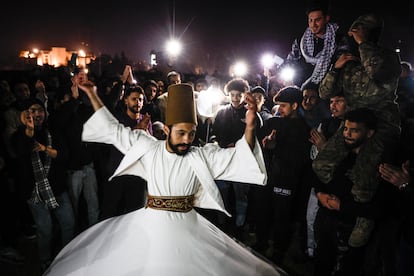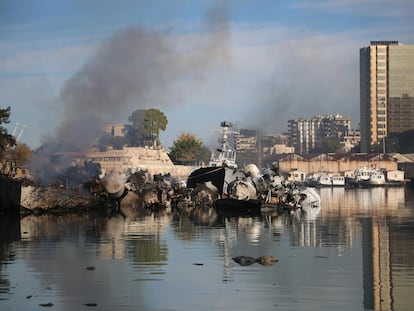To act or not to act in Syria: Trump’s first foreign policy dilemma
The Republican has stated that the United States should refrain from getting involved in the conflict, but events in Damascus could have significant consequences for the national security of the world’s leading power


“The United States should have nothing to do with it. This is not our fight. Let it play out. Do not get involved!” U.S. President-elect Donald Trump posted on social media as Syrian opposition forces stormed Damascus last weekend. Trump, who has consistently opposed U.S. involvement in “endless wars,” is instinctively averse to engaging in the conflict. However, just 40 days after taking office, his administration will be tasked with addressing the unfolding crisis — along with its consequences — in what promises to be an immediate and pressing test of its foreign policy. Despite his rhetoric, the strategy Trump ultimately adopts may end up resembling that of the outgoing president, Joe Biden.
Following the rebel alliance’s lightning offensive, which toppled Bashar al-Assad’s regime in just 10 days, the priority now is ensuring Syria’s stability. The goal is to prevent the Levantine nation — a strategic hub connecting the Mediterranean and Asia Minor, and a focal point for regional powers like Iran, Israel, Turkey, and Saudi Arabia, as well as Russia and the United States — from fragmenting into taifa kingdoms or once again becoming a haven for radical Islamist groups. This scenario is reminiscent of the Islamic State’s caliphate and the chaos that followed the collapses of regimes in Libya, Iraq, and Afghanistan.
The Biden administration has acted swiftly. Key figures in U.S. diplomacy have been deployed to the region. National Security Adviser Jake Sullivan traveled on Wednesday to meet with Israeli officials. Secretary of State Antony Blinken embarked on a diplomatic tour of Jordan and Turkey to discuss the rapidly evolving situation in Syria. Meanwhile, General Eric Kurilla, head of U.S. Central Command, visited Syria to meet with the roughly 900 U.S. troops stationed in the country’s east — a critical component of the strategy to prevent a resurgence of the Islamic State.
The U.S. government has committed to supporting a transition process in Syria that leads to a government reflecting the will of the Syrian people. This transition must meet four key criteria: respect minorities; facilitate humanitarian aid; prevent terrorist groups from using Syrian territory as a base; and responsibly manage the vast chemical arsenal left by the Assad regime.

Caught off guard by the speed of developments in a war that had appeared stagnant after 13 years of conflict, the Biden administration is grappling with how to address rebel groups, particularly Hayat Tahrir al-Sham (HTS). Once allied with Al-Qaeda, HTS remains on the terrorist lists of the United States, the United Nations, the European Union, and Turkey.
“We believe it is in our interest, our national security interest, that Syria be stable and secure and that, again, the Syrian people are able to determine their future. It’s in our interest in the region,” said National Security Communications Advisor John Kirby in a teleconference on Tuesday. “It is also in our interest that we continue to put pressure on ISIS, and so the counter-ISIS mission by our troops in Syria continues.”
These national security priorities will soon fall to the incoming Trump administration, which assumes office on January 20. The fall of the Assad regime, after half a century in power, marks a significant blow to Iran, Assad’s primary regional ally. Iran has recently seen its influence crumble in two of its four strongholds in the region — Syria and Lebanon — leaving it with footholds only in Yemen and Iraq. A stable and prosperous Syria could disrupt Tehran’s supply routes to Hezbollah in Lebanon. Meanwhile, the future of Russia’s military bases in Syria remains uncertain.
Although the Biden administration has taken steps to manage the crisis, its imminent departure means that key decisions on U.S. policy in Syria will be left to Trump, a man who described the country as a land of “sand and death.” What’s more, the president-elect nominated former Congresswoman Tulsi Gabbard to head U.S. intelligence services. Gabbard, who visited Bashar al-Assad in 2017, has argued that while Assad is a “brutal dictator,” his continued leadership may be the best option for controlling terrorist groups.
The current White House has made it clear that it will not make a decision on whether to lift HTS’s designation as a terrorist group, emphasizing that such a decision requires careful study and time. While acknowledging that the organization “is saying the right things at the moment,” the administration has opted to leave this contentious issue for its successors to resolve. Ironically, it was Trump himself who initially blacklisted the group in 2018.
The future of the US military operation
Trump will also face a pivotal choice regarding the U.S. military presence in eastern Syria. Over the weekend, he hinted at potentially ending the mission, a situation reminiscent of 2019, when he announced plans to withdraw U.S. troops supporting Kurdish forces in counterterrorism efforts in northeastern Syria. Ultimately, he reversed course and maintained the existing contingent.
A similar outcome is possible now. “Our troops [are] basically there to fight ISIS and to keep people imprisoned who are imprisoned, former ISIS fighters. If those people get out and commit a terrorist attack against Americans, you get the blame,” said Elliot Abrams of the Council on Foreign Relations during a press briefing this week.
Trump’s team and U.S. allies may counsel him against disengaging from Syria entirely. His nominee for Secretary of State, Florida Senator Marco Rubio, has consistently supported active U.S. involvement in Syria. During the 2015 Republican presidential primaries, Rubio advocated for imposing no-fly zones to protect civilians from Assad’s airstrikes. Similarly, Trump’s incoming National Security Adviser, Mike Waltz, previously criticized Trump’s decision to withdraw U.S. troops from Kurdish border zones, calling it a “grave mistake.”
Although their positions may appear quite different, Biden and Trump’s approaches to Syria are ultimately more similar than they first seem. Biden has underscored the importance of preventing an Islamic State resurgence through a continued U.S. military presence, while emphasizing that Syrians should determine their country’s future.
“If what Trump meant [with his social media post] that ‘this isn’t our fight,’ is that it’s not the U.S. place to engineer Syrian politics from 6,000 miles away, I think that’s pretty wise too,” said Steve Cook, also from the Council on Foreign Relations, at the aforementioned press conference.
“It doesn’t mean that there should be no role for the United States,” he continued. “There is this concern about the real return of ISIS and Al-Qaeda. I think that that’s an important issue that the United States needs to consider. As far as getting involved in arranging the politics of Syria, I think that no good can come from it.”
Sign up for our weekly newsletter to get more English-language news coverage from EL PAÍS USA Edition
Tu suscripción se está usando en otro dispositivo
¿Quieres añadir otro usuario a tu suscripción?
Si continúas leyendo en este dispositivo, no se podrá leer en el otro.
FlechaTu suscripción se está usando en otro dispositivo y solo puedes acceder a EL PAÍS desde un dispositivo a la vez.
Si quieres compartir tu cuenta, cambia tu suscripción a la modalidad Premium, así podrás añadir otro usuario. Cada uno accederá con su propia cuenta de email, lo que os permitirá personalizar vuestra experiencia en EL PAÍS.
¿Tienes una suscripción de empresa? Accede aquí para contratar más cuentas.
En el caso de no saber quién está usando tu cuenta, te recomendamos cambiar tu contraseña aquí.
Si decides continuar compartiendo tu cuenta, este mensaje se mostrará en tu dispositivo y en el de la otra persona que está usando tu cuenta de forma indefinida, afectando a tu experiencia de lectura. Puedes consultar aquí los términos y condiciones de la suscripción digital.
More information
Archived In
Últimas noticias
Most viewed
- Reinhard Genzel, Nobel laureate in physics: ‘One-minute videos will never give you the truth’
- Oona Chaplin: ‘I told James Cameron that I was living in a treehouse and starting a permaculture project with a friend’
- Pablo Escobar’s hippos: A serious environmental problem, 40 years on
- Why we lost the habit of sleeping in two segments and how that changed our sense of time
- The fall of a prolific science journal exposes the billion-dollar profits of scientific publishing










































